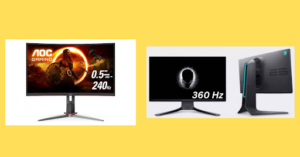240Hz vs 360Hz Monitor

The best monitors with high refresh rates are required for the fastest reaction times in games. Although changing your monitor undoubtedly makes the most impact when it comes to gaming, having the quickest mice, keyboards, headsets, and PC components also greatly improves your reaction times.
It will be much easier for you to win firefights if you have a high refresh rate monitor because it will have less input lag and display your foes a little bit faster. High refresh rate screens are also popular for esports gaming and produce fluid, smooth visuals in casual games.

A 360Hz gaming panel is worthwhile to consider if your PC system can handle more than 240 frames per second.
Even while there isn’t much of a difference between 240Hz and 360Hz, if you’re a professional or prospective competitive player, the expense is justified because every millisecond counts.
The majority of esports players utilise displays that are calibrated at 240Hz, which is the current industry norm. Before upgrading to 360Hz monitors, many professional gamers are waiting for them to include the key qualities and all the minor issues to be resolved. Although 144Hz monitors are currently the most popular ones, upgrading to 240Hz or 360Hz would significantly enhance your gaming experience.
Although most people won’t recognize the distinction between 240Hz and 360Hz unless the two displays are placed near each other, 360Hz is the better option if you want to maximise your advantage and increase performance.

Similar to how a leap from 60Hz to 240Hz or 360Hz is audible but less significant than one from 144Hz to 240Hz. If you currently use a 60Hz display, updating it will transform your gaming experience.
A 240Hz display can refresh the screen 250 times per second with a 4.17ms time between frames, while a 360Hz screen can do the same 360 times with a 2.78ms time between frames. This is the technical difference between the two monitors.
You should make sure the monitor can meet your needs before investing in a speedier one. The display should have a low response, ideally 1 ms, as well as a high refresh rate for competitive gaming. The monitor must have AMD FreeSync or Nvidia Gsync if you frequently play single-player games as a casual gamer to eliminate screen tearing. An HDR display will also improve the visual appeal of games.
To get the most out of the display, make sure your PC can run games at a frame rate higher than the refresh rate of your monitor. Investing cash to upgrade the PC rather than the monitor will be a reasonable alternative if your PC is not able to push games to the desired FPS.
240Hz vs 360Hz
For those who are unaware, the rate at which a monitor can refresh a picture is defined in Hz.
Your monitor can refresh up to 240 times per second if it runs at 240 hertz. A monitor with a refresh rate of 360 hertz can do so.
But unlike the comparison between 144 Hz and 240 Hz, it is not simply true that the higher the number, the better.
240Hz vs 360Hz (Visual changes)
Videos are more persuasive than explanations, however, 240 Hz and 360 Hz have noticeably different smoothness levels.
Whether or not this differentiation is required is the key question. For many professional players, milliseconds can mean the difference between win and defeat, endangering sponsors, ratings, and prize money.
Most casual competitive gamers would save money by opting for a 240 Hz or possibly one of the best 144 Hz monitors instead.
Watch the video below for more proof. Even though we like 360 Hz better, 240 Hz still looks amazing.
Price ( 240hz Vs 360hz Monitors)
Be ready to start at a higher point if you choose to go all-in with a 360hz monitor because higher refresh rates are often more expensive.
Even though 240hz monitors are more and more common, they are usually less expensive even if they might still be expensive.
These screens won’t become any more affordable any time soon because new 1440p 360hz monitors are on the way.
Monitor Requirements: 240Hz vs 360Hz
If everyone is aware, your monitor needs to match the power of your PC or console, and as the balance starts to tip at 360Hz, you need to make sure your system is capable.
For 240 Hz & 360 Hz support, which is currently more of a Computer issue, you’ll need to meet the requirements listed below.
Voltfixer.com claims that an RTX 2080 or at minimum a 1080 GeForce card is absolutely needed for 240 frames per second of gaming.
360Hz 1080p Gaming Monitors
Acer Nitro XV252QF 390Hz monitor
If you need the smoothest performance possible and your computer can produce more than 360FPS, or at least similar to it, we recommend the Acer XV252QF.
The IPS panel features a quick response time, vibrant colours, and a large viewing angle.It allows overclocking to 390Hz, Motion Blur Reduction, which uses light strobing to reduce perceived motion blur, and configurable refresh rates.
Although it is less costly than the 360Hz G-SYNC versions, this type offers an extra 30Hz and is G-SYNC compatible. Additionally, it supports backlight strobing up to 390Hz, compared to the previous models’ 240Hz maximum.
1440p 240Hz Gaming Monitors
The Gigabyte M27Q-X is a 1440p, 240Hz, 1ms display that you may wish to consider instead.
The M27Q-X concurrently supports VRR and MBR up to 240Hz. It also has an Ips screen with a wide colour gamut for richer, more vivid colours. More contrasting colours may be advantageous in competitive gaming since they help opponents guys perform more in specific environments.
We’ve already established that there isn’t a significant difference between 240Hz versus 360Hz, but there is one between 1080p resolution on a 24″ screen and 1440p on a 27″ monitor. Because of this, many gamers will choose 1440p’s crisper, clearer visual quality over 360Hz’s benefits over 240Hz.
Next-Generation Gaming Monitors
The very first 1440p 360Hz & 1080p 480Hz-540Hz sports monitors will make their debut in 2023, so keep an eye out for those. Keep an eye out for them because we keep track of all coming screens in our New Monitors post.
Still uncertain about your needs when it comes to a gaming monitor? We’ll be happy to assist you if you leave a remark below with your expenditure, PC specifications, and list of titles you enjoy playing.
Conclusion:
Finally, it’s crucial to purchase a monitor with desired resolution. Currently, a 360Hz monitor can only support a maximum resolution of 1080p, whereas a 240Hz monitor can handle a maximum resolution of 2K, and the highest resolution is supported by 144Hz monitors. Therefore, a 360Hz monitor might not be the greatest option if your resolution needs are greater than your refresh rate needs.


